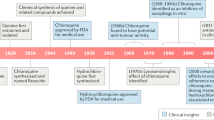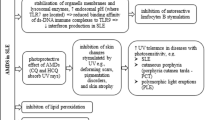Similar content being viewed by others
References
Suarez-Almazor ME et al. (2000) Antimalarials for treating rheumatoid arthritis. Cochrane Database Syst Rev, Issue 4, Art. No CD000959
O'Dell JR et al. (1996) Treatment of rheumatoid arthritis with methotrexate alone, sulfasalazine and hydroxychloroquine, or a combination of all three medications. N Engl J Med 334: 1287–1291
Rynes RI (1997) Antimalarial drugs in the treatment of rheumatological diseases. Br J Rheumatol 36: 799–805
Weber SM and Levitz SM (2000) Chloroquine interferes with lipopolysaccharide-induced TNF-alpha gene expression by a nonlysosomotropic mechanism. J Immunol 165: 1534–1340
Weber SM et al. (2002) Inhibition of mitogen-activated protein kinase signaling by chloroquine. J Immunol 168: 5303–5309
Kim WU et al. (2006) Hydroxychloroquine potentiates Fas-mediated apoptosis of rheumatoid synoviocytes. Clin Exp Immunol 144: 503–511
Leadbetter EA et al. (2002) Chromatin-IgG complexes activate B cells by dual engagement of IgM and Toll-like receptors. Nature 416: 603–607
Kyburz D and Gay S (2003) Toll-like receptors direct antimicrobial immune responses—and drive arthritis? Curr Rheumatol Rep 5: 407–408
van der Heijden IM et al. (2000) Presence of bacterial DNA and bacterial peptidoglycans in joints of patients with rheumatoid arthritis and other arthritides. Arthritis Rheum 43: 593–598
Brentano F et al. (2005) RNA released from necrotic synovial fluid cells activates rheumatoid arthritis synovial fibroblasts via Toll-like receptor 3. Arthritis Rheum 52: 2656–2665
Author information
Authors and Affiliations
Corresponding author
Ethics declarations
Competing interests
The authors declare no competing financial interests.
Rights and permissions
About this article
Cite this article
Kyburz, D., Brentano, F. & Gay, S. Mode of action of hydroxychloroquine in RA—evidence of an inhibitory effect on toll-like receptor signaling. Nat Rev Rheumatol 2, 458–459 (2006). https://doi.org/10.1038/ncprheum0292
Received:
Accepted:
Issue Date:
DOI: https://doi.org/10.1038/ncprheum0292
- Springer Nature Limited
This article is cited by
-
Azathioprine and hydroxychloroquine overdose in Sjögren’s syndrome patient with hypocalcemia: a case report
Journal of Medical Case Reports (2024)
-
Current treatment of systemic lupus erythematosus: a clinician's perspective
Rheumatology International (2023)
-
Antimalarial drugs—are they beneficial in rheumatic and viral diseases?—considerations in COVID-19 pandemic
Clinical Rheumatology (2022)
-
Inhibition of NETosis for treatment purposes: friend or foe?
Molecular and Cellular Biochemistry (2022)
-
The effect of an electronic medical record intervention on hydroxychloroquine prescribing habits and surveyed providers’ opinions of the 2016 American Academy of Ophthalmology guidelines in the rheumatology and dermatology practices of an academic institution
BMC Health Services Research (2021)





